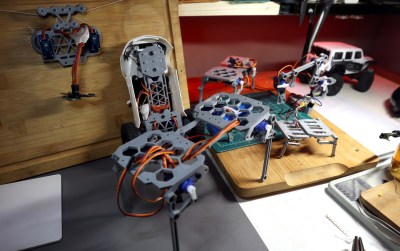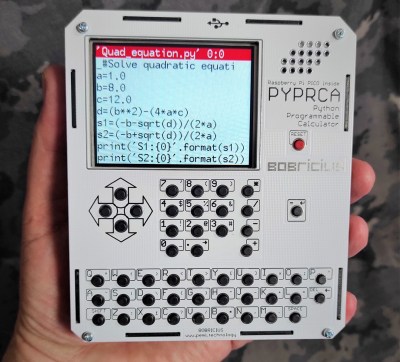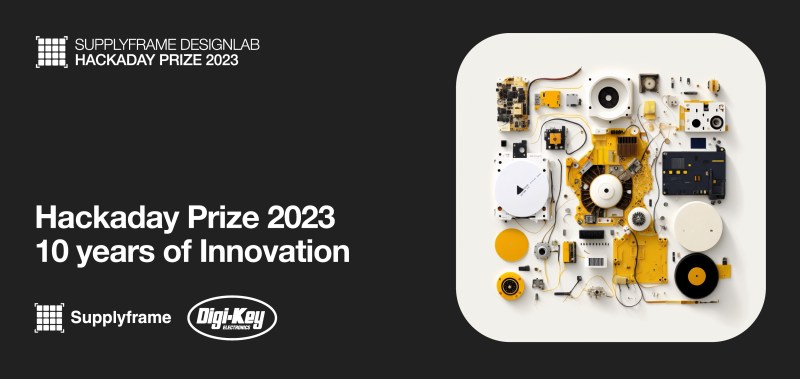They say time flies when you’re having fun, and doubly so when you’re hacking hardware. If you can believe it, we’ve already closed out the first challenge of the 2023 Hackaday Prize, and you know what that means — it’s time to announce the 10 finalists.
As a reminder, each of these projects not only takes home $500 USD, but moves on to the next round of judging. During the recently announced 2023 Supercon, we’ll announce the six projects that were selected by our panel of judges to collect their share of $100,000 in prize money– plus a residency at Supplyframe’s DesignLab and eternal hacker glory for the Grand Prize winner.
Teaching the Next Generation
The Re-engineering Education challenge asked hackers to come up with ideas that would help others learn new skills. As anyone reading Hackaday knows, learning is more than sitting down in a classroom with a textbook, so the best entries in this category were the ones that were interactive and promoted a hands-on approach.

For example, several of the finalists focus on robotics. There’s perhaps no better or more engaging way to get young people excited about STEM than having them build their own robots. But it can be a tall order for some schools, which is why projects like the $10 Robot from Neil Lambeth are so exciting. Dropping the cost of the bot’s control board down to the bare minimum not only means more schools can afford this kind of curriculum, but that students might even able to take their creations home to keep rather than having to leave them in the classroom.
Similarly, Saul’s Bolt Bots project aims to reduce the upfront cost of building robotic platforms by using 3D printed frame components and off-the-shelf servos. Finally, EL-KiDS from Sekolah Robot Indonesia uses a modular no-code approach to building robots which is perfect for younger students.

The judges were also impressed with a number of computing projects. While affordable Linux-powered Chromebooks have become a welcome sight in many schools, they’re best used for consuming media and doing classwork — you won’t learn much about the nuts and bolts of computing with one.
For that, you need something like Lee Hart’s 1802 MemberChip Card. This pocket-sized computer uses RCA’s 1802 microprocessor and 64 KB of memory (split between RAM and ROM) to run BASIC, FORTH, LISP, and a few games. Best of all, students can build it themselves with the help of a Heathkit-style instruction manual.
We also saw a number of mobile computing devices entered into the Re-engineering Education challenge, such as the Python Programmable Calculator (PYPRCA) by bobricius and the NEOklacker by Spider Jerusalem. While you’ll find few students without their own mobile gadgets these days, the same rule applies as with the Chromebooks; they’re great tools, but you don’t learn much about what actually makes them tick by using them. Giving students a mobile device they can build, tweak, and rebuild, offers a whole new world of possibilities.
Re-engineering Education Finalists
Lending a Hand
The Re-engineering Education challenge might be over, but the 2023 Hackaday Prize is just getting started. We’re currently in the middle of the Assistive Tech challenge, which tasks hackers with developing devices that can help those with disabilities earn back a bit of their independence — a noble goal if there ever was one. Afterwards, we’ve still got three more challenges to go before this year’s competition crosses the finish line.
As always, we wouldn’t be able to put on the Hackaday Prize — now in its tenth year — without the support of our incredible sponsors. Special thanks to Supplyframe and Digi-Key for helping us bring these ideas to life.
Late-breaking News (2023-05-15): The ESPboy project didn’t meet the requirements for an entry into the Hackaday Prize, and we only noticed this after the fact. We’re dropping it from the finalists, and so the next-up project, the Lu.i Educational Neuron, gets in. This project is so good that we’ve featured it before, and we’re stoked that it gets added to the list of finalists.

















Many of these are quite good projects, too bad they don’t have their own article to present them and why they were chosen. A theme like this is good because It allows to highlight projects that take into account accessibility (technical and economic) and not only projects implementing “cutting edge” technologies.
Accessibility is the predominant factor in enabling the teaching of electronics to children. If we take El-kids as an example, the existing commercial solutions are superior, but are totally out-of-budget for schools in Indonesia or out-of-reach for your average teacher.
Congrats to all the winners!
1802 MemberChip card? Don’t these get judged on being open? A closed source commercial project made it through? A binary ROM and a schematic with no PCB layout seems a bit .. odd.
It’s a nice old project from 2018 but… weird pick is all.
Actually, it *is* open source. The software sources are on the various author’s github pages. I used OrCAD for the PCB, which is a DOS program from the 1990’s. I’d be happy to share the files, but they won’t be usable unless you also download OrCAD (which is freeware). But I’ll post the Gerbers, if that helps.
I’m flattered that you thought it was a commercial product. TMSI is just my one-person hobby (That’s My Self and I). I offer kits so others can more easily build my projects themselves. But everything is there for free if you want to make it from scratch yourself.
It’s preferable that entries be open source, and the judges will generally take the relative “openness” of a project into account. But no, it’s not required for an entry to be open source.
“But no, it’s not required for an entry to be open source.”
Because this Hackaday, it it ain’t open, it will be!
B^)
Congratulations to winners..
Is it possible to re-enter my project ‘vimana stem for all” in save the world wild card round?
My be something missed in efforts so will add more value to it in mean time and re-enter again..
https://hackaday.io/project/190462-vimana-stem-for-all
Cheers,
Ravi
I like Lee’s project a lot and just from the amount of effort put into it over the last five years it certainly deserves a prize of $500.
However – it severely falls short regarding the competition rules.
I hate to single out Lee’s project, but it’s just a really good example. Some of the others fall short too, especially regarding requirement #7.
“4. Link to any repositories (e.g., Github).” <- None linked even though Lee mentions they exist above.
"5. Document all open-source licenses and
permissions as well as any applicable third-party
licenses/restrictions." <- Mentioned above but none documented.
"7. Show at least two (2) Project Log or Instruction
updates on your Project Profile." <- 0 logs and 1 instruction: A link to the sales pages.
And the weighting criteria:
"i. Is this a unique solution to a particular challenge facing the world today?" <- Uhm.. Not really – to be fair, a lot more five years ago though.
"ii. How thoroughly documented were the design process & design
decisions?" <- They were not – the manual doesn't discuss the design and decisions.
"iii. How easily can this design be implemented by other people in future
projects?" <- It can't. At the time of judging no gerbers were available.
"iv. How complete is the project?" 100% complete.
Absolutely no offence to Lee, I like it a lot, but why have rules if the judges don't care to use them?
Need to have some feedback from the judges as to what they thought about the projects. Even if it’s just a few sentences for each one.
Yes.. Would be really appreciated… If got some feedback…
Espboy project created in 2019 as per project page..
While official rule point 2 – eligibility clearly states that
1. A new project page must be created.
2. The project must be significantly different from when previously entered
and show meaningful development during the course of the Contest.
None followed in this case..
So in favour of stating that, if there is no value of official rules than why they are in place …
I had a project that got through round 1 of the Hackaday Prize a few years ago and it did not meet the number of logs criteria. Somebody, quite rightly, complained and it got booted out of that round and somebody else’s project got promoted to ‘winner’ status.
The ESPboy project does look well dodgy. Dates back to 2019 and created by someone in Russia: “RomanS IT project manager, ESPboy developer
Saint-Petersburg”. Come on Hackaday admin …. pull your socks up!
According to the project page, 1802 MemberChip Card has also not officially entered the 2023 competition. There are a lot of things wrong.
Looks like it is to me. Double-check?
The judging is also done on a snapshot of the entries at the time of the deadline. Which is another way of saying, I don’t believe that the project was entered after the fact either.
I’m not seeing a problem here, but it might be worth the prize admin checking the relevant dates here just in case they entered retrospectively.
Thank you, Cyclops! Frankly, I hadn’t seen these rules before, and didn’t realize they were needed. The 1802 MemberChip Card is my first submission to Hackaday.io so I’m learning and fixing things as I go.
The project isn’t aimed at experienced hackers, but rather at beginners. The manual, documentation, links, and even a kit with all the parts were created so a beginner can easily get everything from one place.
Expert-level support seemed out of place for this project. A beginner won’t know how to use github, run assemblers, program EPROMs, use PCB fab houses, and find all the parts himself. But I can supply all this data now that I know it’s needed.
No, the project isn’t 100% finished (is any project?) I’m still writing the manual, and just barely started on I/O boards and applications for it. It needs more on the various sample languages, and a theory of operation section is a great idea.
If there are other things I should do, just ask!
@Lee, I guess you didn’t think it would come this far :)
The rules are pretty clear on what needs to be in order by the challenge due date, and you didn’t know so you didn’t fix it. Like Tom said, source code isn’t a strict requirement but I believe people have been disqualified before for not having the required 2 logs or instruction updates by the challenge deadline, and yours were missing.
Your project was also missing submission to the actual “Hackaday Prize 2023”, a small detail.
I think Hackaday sends out reminders close to the due date so you have a chance to fix these small missing things – maybe they didn’t this time and that’s why they let it slide.
I hope your project doesn’t get disqualified – really awesome work so far – but it wasn’t really within the rules – neither was the ESPBoy, but I doubt that was under the same circumstances.
I think most users on hackaday.io know how to program a ROM, and download and send gerbers to asia, though.
And moreover, ESPboy is just a re-entry of the 2019 Hackaday prize without redesigning the project accordingly. The project is not even submitted for the Hackerday prize 2023, probably because it doesn’t work with the Hackaday prize 2019 tag.
ESPboy is just a Hackaday Prize 2019 re-entry. Others have at least made the effort to create a new project. Legally, it is not even an entry for the Hackaday prize 2023, since it was not submitted for it. When submitting for the Hackaday prize 2023, some questions have to be answered.
Exactly… rightly pointed out.. espboy Project was not showing submitted for re-engineering education..nor submitted for hackaday prize 2023…
Not even in list of project submitted for this contest..
How come it appears as a finalist…it’s really serious concern.. and need to be addressed by hackaday..
Somebody should be in charge of the competition and they would be the person to contact, but I’ve no idea who they are :(
I’ll pass this on and see what can be done.
And yeah. Looks like this was a mistake.
A new person is coordinating the judging, and didn’t go over the rules-eligibility check finely enough. They know about it now.
We’ll be picking the “11th place” entry and pushing that into the finalists list instead. Stay tuned.
Seems like someone cares enough to delete (or hide?) my initial comment about espboy being a russian device with author not caring about the war russia started. I wonder if it’s Hackaday official policy now to hide anything that reminds that the war is going on?
No …… WordPress would have auto quarantined your comment. Just be wary to avoid certain key words like the name of a recent American politician found to be fond of abusing women.
That is super weird – it doesn’t even show as a re-entry. Just a 2019 entry. It does show as submitted for Re-engineering Education – but the project page is the one from 2019.
I’m pretty sure a new project page has to be created if reusing a project – and it has to show some progress since.
ESPboy – RetroGaming&Software development MuliTool is a project of a russian developer and already participated in the competition in 2019. At a minimum, this is a violation of the rules of the competition, at a maximum, it is support for an aggressor country that has launched a full-scale invasion of another country. And this is especially strange when the Tindie platform itself and electronics manufacturing plants have not been providing sales and manufacturing services for electronics for russia for some time.
+1
As a few comments have mentioned it would be great to receive feedback on project submissions to find out where we could do better. I really thought my project had it all!
Congrats to the winners!
Reading more on these amazing projects that were selected it seems like they are all STEM education tools. The contest rules seemed to indicate that other forms of educational tools would qualify based on the “and/or” in the contest rules so I’m surprised not to see any. Is it coincidence that no other forms of education tool made it through or were they filtered out?
“Build a hardware solution that supports educators and/or students and/or makes STEAM education more accessible and/or effective.”
umm where is my $500 lol boltbotz.